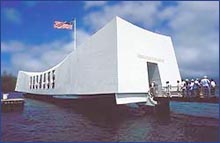The National Park Service

Visit an American treasure
by Elissa Haney |
 The National Park Service maintains hundreds of outdoor parks...  . . . as well as historic areas in places as far-flung as Hawaii–where tourists can visit the USS Arizona memorial–and American Samoa. Related Links |
Chances are you've been to a park or historic area in the National Park System at one time or another. If it was in 2015, then your visit was one of an impressive 307,247,252 total recreation visits made to System sites last year alone.
To put that in perspective, consider that according to the Census Bureau the population of the United States is over 321,418,820. Statistics aside, if you've ever tried to make a last-minute lodging reservation during the summer, you're already well aware of the popularity of the National Parks.
History of the Park System
On August 25, 1916, President Woodrow Wilson signed the act that established the National Park Service as an office of the Department of the Interior.
The government’s aim, as stated in the National Park Service Organic Act of 1916, was to "conserve the scenery and the natural and historic objects and the wild life therein and to provide for the enjoyment for the same in such manner and by such means as will leave them unimpaired for the enjoyment of future generations."
National Park Fun Facts
- When Congress passed the Act of March 1, 1872, it established Yellowstone National Park as the first national park in the world.
- About 1,200 national park areas now exist in more than 100 nations.
- The U.S. National Park System today comprises 410 areas, totaling more than 84 million acres.
- Delaware is the only state that does not contain an area in the National Park System.
- New National Parks can only be established by acts of Congress.
- About 246,000 people across the U.S. volunteer in the parks each year.
- The largest area in the system is Wrangell-St. Elias National Park and Preserve in Alaska. At 13,200,000 acres (including the park and preserve), it composes 16.3% of the entire system.
- The smallest area is the Thaddeus Kosciuszko National Memorial, in Pennsylvania, at 0.02 acres. It commemorates the life and work of this Polish patriot and hero of the American Revolution.
